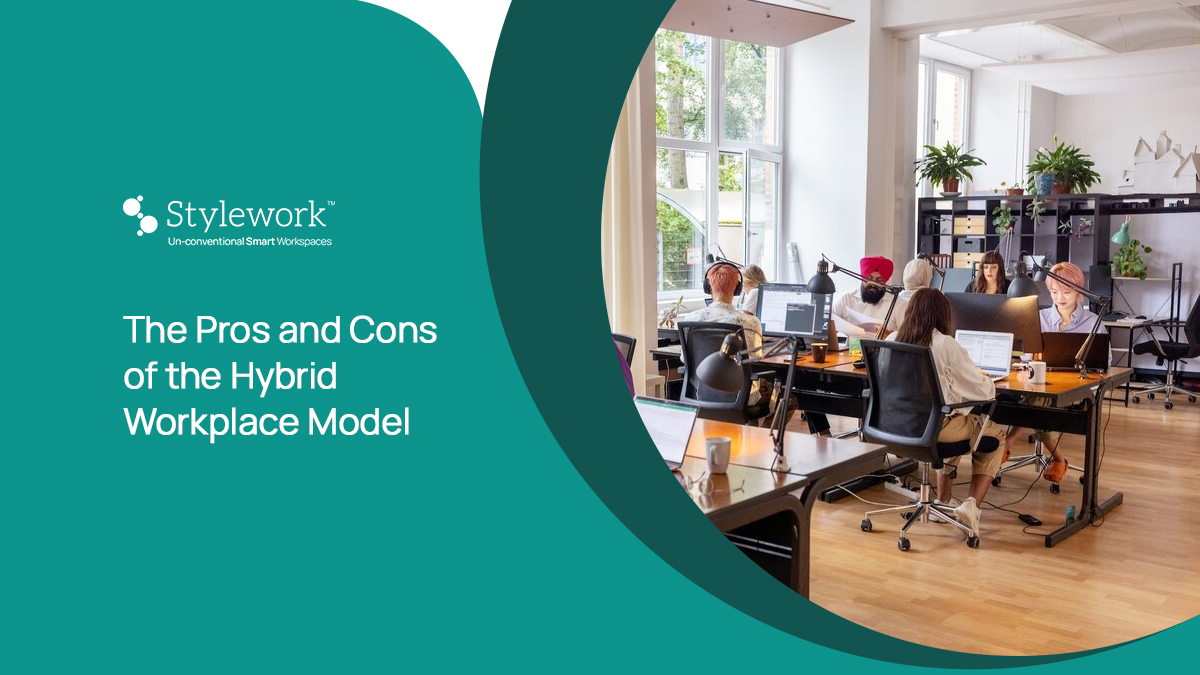To hybrid or not to hybrid, that is the question. Hailed for blending the best of both worlds, hybrid working is a trend here to stay.
With employees flocking back to the office, the hybrid work model is rapidly becoming the standard for numerous employees with the ability to work remotely.
In the hybrid workplace model, employees have the flexibility to complete their tasks both in the office and, occasionally, from alternative locations, such as their homes or flexible workspaces like flexible coworking spaces, shared office spaces, and more.
While there are numerous benefits of hybrid work, it is always wise to consider both sides of the coin. So, what are the pros and cons of this popular model? Let’s take a look and find out.
Pros of the Hybrid Workplace Model
1. Emphasis on productivity over efficiency
The hybrid work model prompts a reevaluation of performance metrics, emphasizing increased productivity. With remote work, specifying project responsibilities and transparently gauging achievable tasks daily becomes critical.
Therefore, management focuses on productivity over maximizing hours, ensuring teammates have essential resources, and ensuring projects follow a well-defined workflow.
Flexboard by Stylework is an optimal hybrid workforce management solution that allows you to supervise your hybrid workforce more effectively. This tool not only optimizes office space utilization and enhances workspace allocation but also boosts productivity and cost-effectiveness. Flexboard is specifically tailored to manage flexible coworking spaces for employees.
2. Reduced Operational Expenses
With fewer employees present at the office, employers require less office space and hence turn to hybrid office spaces. The hybrid workplace model not only results in cost savings on rentals but also reduces the need for office supplies. The model also translates to less time and money spent on commuting for employees.
Stylework’s flexible workspace membership plans—fixed and multi-locational—allow you to access premium shared coworking spaces and managed workspaces, in addition to multiple flex workplace seating options ranging from hot desks and flexi desks to private cabins, meeting rooms, conference rooms, and flexi day passes.
Also Read: Managed Office Space
3. Redefining Collaboration
The hybrid work model fosters open-layout flexible workplaces like shared coworking spaces, flex desk environments, etc., promoting better collaboration. Team members are not confined to their workstations, encouraging the free exchange of ideas and brainstorming. Moreover, flexible coworking spaces and hybrid workplaces are home to vibrant communities that thrive on dynamic collaboration, fostering innovation, and shared success.
4. Employee prioritization
The hybrid workplace model fosters better work-life balance for team members by providing flexibility in organizing their time. This autonomy leads to time and cost savings, particularly for those who have daily commutes. A well-structured hybrid work model not only offers tangible health benefits but also enhances employee satisfaction, overall well-being, and retention, contributing to a positive and sustainable work environment.
Also Read: What is Hybrid Work, and Why Do Employees Desire it?

Cons of the Hybrid Workplace Model
1. Increased employee isolation
Working alone for extended periods of time can breed isolation, impacting employees’ mental well-being. Without daily office interaction, camaraderie built through being physically present in the office also weakens, leaving some employees demotivated and lonely. It might also become harder to exchange ideas, and communication will become much more intentional.
Adopting the hybrid workplace model can help prioritize employee well-being by giving them the freedom to work remotely and onsite as and when they like.
Also Read: How are People Moving Towards Hybrid?
2. Heightened Cyber Risks
Cyber-attacks and data loss risks increase with remote work. Companies must fortify their digital security with regular software updates, robust password management, and multi-factor authentication, in addition to hybrid activation in their hybrid office spaces, to mitigate data breach risks.
Employers also end up bearing the responsibility of retraining workers on secure connections, data backup, and recovery plans to ensure a resilient remote and hybrid workforce.
3. Proximity Bias
Concerns about fairness in a hybrid work model arise when supervisors may favor in-office employees over those working predominantly from home. This dynamic, measuring loyalty by physical presence, risks dividing employees and creating feelings of inequality based on location and schedule, impacting overall cohesion. Addressing these concerns is vital for maintaining harmony in a hybrid workplace environment.
4. Employee Burnout
Remote workers often struggle to define boundaries between work and home life. They might end up working extended hours without breaks, thereby risking exhaustion. While onsite, employees might find long commutes to reach the office arduous and might have to adjust their personal routines.
These challenges can overwhelm employees, potentially leading to burnout. Finding strategies to manage work-life balance and alleviate the stressors associated with remote work and commuting is essential for preserving employee well-being in diverse work scenarios.

Stylework’s Role in Crafting a Hybrid Workplace
Unlock the potential of hybrid workplaces with Stylework, India’s leading flex workspace aggregator at the forefront of the Hybrid Work Revolution.
Stylework’s contemporary workplaces, tailored for the modern workforce, feature best-in-class amenities and foster a work environment that boosts productivity and enhances employee well-being. Our meticulously crafted flexible office space solutions, including flexible coworking spaces, shared workspaces, and more, align seamlessly with the present-day hybrid workplace model.
So, what are you waiting for? Connect with us today to discover the perfect flexible workspace tailored to all your hybrid work needs.

